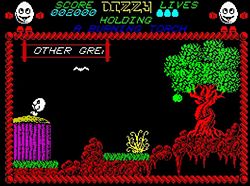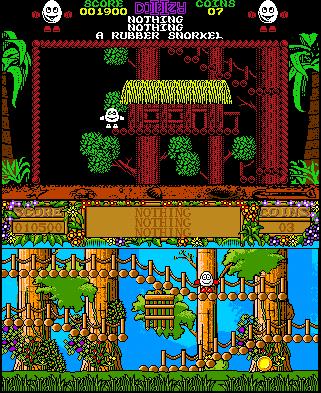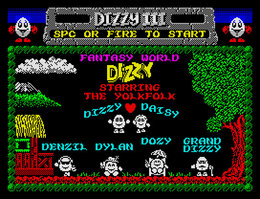Dizzy (series)

According to The Oliver Twins, "this was the first illustration to really capture the spirit behind Dizzy. It's the box artwork by Alastair Graham for Fantasy World Dizzy."[1]
Dizzy is a series of video games initially created by The Oliver Twins and published by Codemasters between 1986 and 1993. With the exception of The Fantastic Adventures of Dizzy, the games were only released in Europe. All of the games were originally created for the Amstrad CPCand ZX Spectrum, however most of the games were quickly ported over to other systems including the Commodore 64, Atari ST and Amiga. Some of the later games were also released for the NES, Game Gear, Mega Drive and DOS.
There are two main types of Dizzy game. The first type, which include the first two games released, are platform-adventure games. These are considered to be the main or core games in the series. In addition a number of small action games were released between the main games. These are generally considered spin-offs.
Recurring Characters
The Yolkfolk
With a few exceptions, the cast of 'good guys' in the Dizzy series consists mainly of Dizzy and his family, collectively known as 'The Yolkfolk'. Each of these characters are eggs that wear boxing gloves, and are all visually similar except for one or two minor differences.
The only playable character in each of the Dizzy games is an egg known as Dizzy, however he was not intended to be an egg when created. The Oliver Twins felt that due to the graphical limitations at the time it was hard to identify with most video game characters, and they decided that the best way to counteract this was to focus on the most personable part of the character - the face.
One morning we were just playing around with how big we could get a face on screen, but that obviously meant not giving it a body. We ended up drawing the biggest face we could and simply added arms and legs to it so it actually held together and you could run it around the screen. — Philip Oliver, interview with Gamestation magazine[2]
An advantage of this was that the simply character was easy to animate, and the character was given a bounce when he stood and a somersault when he jumped. This inspired the name, Dizzy, and when people played the first game many of them immediately saw Dizzy to be an egg, and The Oliver Twins decided to run with this concept.
Dizzy was given red gloves (later decided to be boxing gloves) and red shoes. He has no other identifiable features. Due to his exploits he is often seen as the hero of the village.
Most of the rest of the Yolkfolk were introduced in Fantasy World Dizzy. Of these, the most significant is Daisy. Daisy is Dizzy's girlfriend. She is kidnapped or otherwise in peril several times throughout the series, and the goal of several games is to rescue her. She can be identified by her hair.
The other Yolkfolk introduced in Fantasy World Dizzy are:
- Dylan, a hippie, who is implied to be interested in certain illegal substances which often result in him entering a trance-like state. He can be identified by his hat.
- Denzil, the 'cool' member of the Yolkfolk, is never found far from his music and often cannot be bothered to talk to the others. He can be identified by his headphones and shades.
- Dozy, who is interested in almost nothing except sleep - often to the point that he cannot be woken. He has no physical identifying features, but can be identified by the ZZZZ's floating from his head signifying his snoring.
- Grand Dizzy, the elder of the Yolkfolk, is Dizzy's grandfather. He likes nothing more than telling everyone about tales of his youth, and doesn't seem to notice when nobody is around to listen to him. In Fantasy World Dizzy he can be identified by his walking stick and moustache, however in later games the moustache was replaced with a beard.
There were also two late additions to the Yolkfolk. First seen in Magicland Dizzy, Dora is Dizzy's younger sister, who can be identified by the bow in her hair. The other late addition is Danny, who never actually appeared in a published game. Prior to the release of Magicland Dizzy a mini-game called Dizzy 3.5: Into Magicland was released on the cover of some UK magazines, which was like the main games but consisted of only five screens and was only for promotional purposes. Danny was in this mini-game, and could be identified by his unusual posture.
The Good Wizard Theodore
Pogie the Fluffle
The Evil Wizard Zaks
Platform-adventure games
Dizzy: The Ultimate Cartoon Adventure

There were many hazards to avoid in the original game, including the bird and the apple shown here.
Dizzy was exploring a haunted forest when he found an ancient inscription in a stone slab titled "The Avawiffovee Potion", known through legend as the only way to get rid of two things - athletes foot and the Evil Wizard Zaks. With Zaks terrorising Dizzy's home village, Dizzy knew that if he could make the potion and destroy the wizard then he would be a hero. The slab gave the instructions for creating the potion, just "fill a potion bottle with cooked Leprechauns wig, cloud silver lining, Vampire dux feather and some troll brew - cook the potion and throw it at Zaks to dissolve his reign."[3] Covering up the slab once more, Dizzy set off to collect the ingredients and liberate the land of Katmandu.
Dizzy: The Ultimate Cartoon Adventure was created by The Oliver Twins and released in June 1986. Due to the technical limitations of computer systems at the time the graphics are quite poor in comparison to the rest of the series and use only four colours. However for the time these were excellent, and the game was described by critics as having "very good cartoon-type graphics with plenty of colour"[4].
This game was a lot more action-oriented than later games in the main series. Hazards that could kill Dizzy were many, ranging from spiders and bats to raindrops and apples. Unlike most of the hazards from later games in the series, some of these hazards could be 'killed'. Birds could be defeated using ACME bird seed, raindrops could be defeated using a rain coat and apples falling from trees could be defeated using a hard hat.
Dizzy began the game with three lives, but unlike in other games he could gain extra lives by collecting small flashing eggs. The more complex inventory systems of later games had not yet been developed, and Dizzy could only carry one item at a time. This required a lot of forward planning in, or back-tracking, in order to get the correct items to the right place.
Treasure Island Dizzy

The graphical capabilities of computers at the time varied significantly, so the visual representation of the games differed drastically between systems. Here you can see the difference between the Commodore 64 version of Treasure Island Dizzy at the top, and the Amiga version of the same game at the bottom.
Dizzy was enjoying a round-the-world cruise that he had booked and paid for, even though the ship was run by pirates. He was having a good time when one afternoon Dizzy decided to organise a game of cricket on the aft deck. Stupidly he decided to use the Captain's spare wooden leg collection as the stumps, and when they were lost overboard the Captain forced Dizzy to walk the plank! Stranded on a deserted island, Dizzy had to find his way back to the village and lodge his compensation claim with the travel agent.
Treasure Island Dizzy was created by The Oliver Twins and released in August 1987.
One of the biggest differences between Treasure Island Dizzy and all of the other main games is that Dizzy only had a single life. If the player made a mistake and died, they had to restart the game from the beginning. This made the game a lot more difficult than the rest of the series as there was no room to make mistakes. This was not a planned feature, and for most of the game design process Dizzy had three lives as in the original game. However, very late in the testing process a major flaw was found.
The one life was due to a logic bug. We found that if the player put down an object underwater or on the far beach it was extremely easy to drown poor old Dizzy. He'd be reset to the beach but be unable to get the snorkel or the items left on the far beach - making the game impossible to complete. We were under a huge amount of pressure to deliver the game so we ran out of time to solve that problem. It left us with only one option - we had to remove the other lives. — Philip Oliver, interview with Retro Gamer[5]
This was also the first Dizzy game to allow more than one item to be carried. Three items could be carried in the inventory, which was represented by a list at the top of the screen. The system was not very intuitive however, and used a scrolling system. When the game was started each inventory slot was empty, and this was represented at the top of the screen as nothing, nothing, nothing on the three lines representing the inventory. When the player collected an item it the words would scroll up the screen, with the top 'nothing' vanishing as it moved out of the inventory area. The item that was picked up would scroll into the bottom slot. The inventory would now read nothing, nothing, an old solid chest. When the player next pressed the pick-up/drop button, the inventory would again scroll up. Nothing would actually be dropped as the top item was 'nothing', and the item at the bottom would move into the middle position. The button had to be pressed two more times in order to drop or use the item - once to move it to the top position, and once more to actually drop it.
There were a couple of disadvantages with this system. If the player only held one item but it was in the top slot, picking up a new item would simultaneously drop the old item despite having two empty slots in the inventory. Also, if the player was holding three items and wished to use the one in the bottom slot, they first had to drop the top two items in order to reach the item they desired to use. This was especially awkward in the underwater areas of the game, as Dizzy could not breath underwater unless he was holding the snorkel and if the snorkel was ever dropped whilst Dizzy was underwater then Dizzy would drown causing the game would be over. If the player was underwater wished to pick up an item but the snorkel was in the top slot they first had to move to dry land, drop the snorkel, pick it up again and return to the item they wished to collect.
This game was also the first one to feature an optional collection quest, something that recurred in later games. Scattered throughout the world were 30 gold coins. Dizzy had to collect all of these in order to fully complete the game, however some of them were difficult to find after being hidden behind pieces of scenery that had to be picked up in order to reveal them. Gold coins were not stored in the inventory, however picking one up did cause the inventory to scroll.
Fantasy World Dizzy
Fantasy World Dizzy was created by The Oliver Twins and released in October 1989.
Magicland Dizzy
Magicland Dizzy was created by Big Red Software and released in December 1990.
Fantastic Dizzy
Fantastic Dizzy was created by The Oliver Twins and released in April 1991.
Spellbound Dizzy
Spellbound Dizzy was created by Big Red Software and released in November 1991.
Dizzy: Prince of the Yolkfolk
Dizzy: Prince of the Yolkfolk was created by Big Red Software and released in December 1991.
Crystal Kingdom Dizzy
Crystal Kingdom Dizzy was created by Visual Impact and released in December 1992.
Action games
Fast Food Dizzy
Fast Food Dizzy was created by The Oliver Twins and released in December 1987.
Kwik Snax
Kwik Snax was created by The Oliver Twins and released in November 1990.
Bubble Dizzy
Bubble Dizzy was created by The Oliver Twins and released in November 1990.
Dizzy Panic!
Dizzy Panic! was created by Big Red Software and released in May 1991.
Dizzy Down the Rapids
Dizzy Down the Rapids was created by The Oliver Twins and released in April 1991.
Go! Dizzy Go!
Go! Dizzy Go! was created by The Oliver Twins and released in November 1993.
References
- ↑ http://www.olivertwins.com/yolkfolk.htm - Dizzy And The Yolkfolk..., The Oliver Twins
- ↑ http://www.yolkfolk.com/site/image.php?image=gamestm/gamemag3.jpg - The original good egg, Gamestation magazine
- ↑ Dizzy: The Ultimate Cartoon Adventure instruction manual
- ↑ http://www.yolkfolk.com/site/image.php?image=magazines/Crash4600134.jpg - Dizzy review, CRASH magazine, November 1987.
- ↑ http://www.yolkfolk.com/site/images/magazines/RetroGamer_TIDArticle_Page1.JPG - The Making of Treasure Island Dizzy, Retro Gamer
